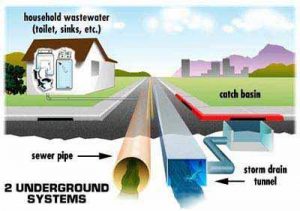 Your home’s drainage system uses gravity to pull water through the house and outside to drain. Waste and dirty water is piped through a “Soil Stack” which in turn takes the waste through a main drain, generally located underneath the house.
Bends in the pipe called “Traps” prevent waste odors from escaping through the pipes. Vents prevent these gases from escaping through the house. Your plumbing is usually vented through your roof through the “Main Stack”.
Your home’s drainage system uses gravity to pull water through the house and outside to drain. Waste and dirty water is piped through a “Soil Stack” which in turn takes the waste through a main drain, generally located underneath the house.
Bends in the pipe called “Traps” prevent waste odors from escaping through the pipes. Vents prevent these gases from escaping through the house. Your plumbing is usually vented through your roof through the “Main Stack”.
Drainage System Terms:
- House sewer: A pipe that runs between the house drainage system and to the public sewer or septic tank.
- House drain: The lowest part of a home drainage system, this pipe receives the discharge from soil, waste, and other drainage pipes, and then carries such discharge to the house sewer. The house drain ends just outside the front or foundation wall of the building, and operates by gravity.
- Soil stack and pipe: Any line of pipe which carries the discharge of toilets. The term “stack” refers to the vertical runs of such piping.
- Waste stack and pipe: All pipe receiving the discharge of fixtures other than toilets. An indirect waste pipe does not connect directly with either the house drain or the soil or the waste stack, but usually ends over and above the overflow rim of fixture that is water-supplied, trapped, and vented.
- Trap: Refers to a fitting or device constructed to prevent the passage of air or gas back through a pipe or fixture, without materially affecting the flow of sewage or wastewater.
- Vent piping: Provides ventilation to the drainage system and prevents trap siphonage and back pressure from clogging or contaminating the drainage system. Local ventilating pipe is a duct or pipe connected to the house side of a fixture or trap through which foul vapors may be removed from a room.
- Sub-house drain: Any portion of the drainage system which cannot drain by gravity but which still handles the disposal of waste sewage.



